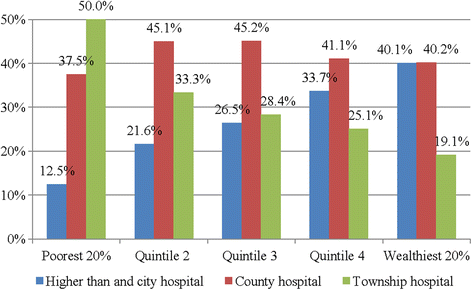Who benefited from the New Rural Cooperative Medical System in China? A case study on Anhui Province
- PMID: 27262341
- PMCID: PMC4893416
- DOI: 10.1186/s12913-016-1441-3
Who benefited from the New Rural Cooperative Medical System in China? A case study on Anhui Province
Abstract
Background: The goal of the New Rural Cooperative Medical System (NCMS) is to decrease the financial burden and improve the health of rural areas. The purpose of the present study is to determine how government subsidies vary between poorer and wealthier groups, especially in low-income regions in rural China.
Methods: The distribution, amount, and equity of government subsidies delivered via NCMS to rural residents at different economic levels were assessed using benefit-incidence analysis, concentration index, Kakwani index, Gini index, Lorenz curve, and concentration curve. Household and health institution surveys were conducted in 2010, covering 9701 residents. Household socio-economic status, healthcare costs, out-of-pocket payments, and utilization information were collected in household interviews, and reimbursement policy was provided by institutional survey.
Results: The government subsidy concentration index was -0.055 for outpatients and 0.505 for inpatients; and the outpatient and inpatient subsidy Kakwani indexes were -0.376 and 0.184, respectively. The poorest 20 % of populations received 3.4 % of the total subsidy output; while the wealthiest 20 % received 54.3 %. The results showed that the distribution of outpatient subsidies was equitable, but the hospital subsidies disproportionally benefited wealthier people.
Conclusions: Wealthier people benefited more than poorer people from the NCMS in terms of inpatient and total subsidies. For outpatients, the subsidies were unrelated to ability to pay. This contradicts the common belief that the NCMS does not exacerbate benefit inequity. Long-term policy is required to tackle this problem, specifically of redesign the NCMS reimbursement system.
Keywords: Benefit incidence analysis; Concentration index; Kakwani index; NCMS; Subsidy.
Figures
References
-
- Xinhuanet. Com, China achieves 99 pct rural healthcare coverage. 2013, http://news.xinhuanet.com/english/china/2013-08/23/c_132657777.htm.
-
- The Ministry of Health, China . The notice of preparation for the new rural cooperative medical in 2012. Beijing, China: The Ministry of Health; 2012.
MeSH terms
LinkOut - more resources
Full Text Sources
Other Literature Sources
Medical




